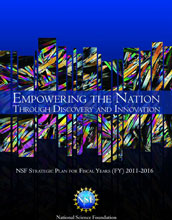News Release 11-093
NSF Announces Its Strategic Vision for Road Ahead
The agency's strategic plan for 2011-2016 sets transforming the frontiers, innovating for society and performing as a model organization as key goals

Empowering the Nation Through Discovery and Innovation: NSF Strategic Plan for FY 2011-2016
May 10, 2011
This material is available primarily for archival purposes. Telephone numbers or other contact information may be out of date; please see current contact information at media contacts.
The National Science Foundation (NSF) recently released a strategic plan to guide the agency's priorities and investments for the next five years. Empowering the Nation Through Discovery and Innovation: NSF Strategic Plan for Fiscal Years 2011-2016 sets the pathway for the agency's future, refining NSF's vision statement, refocusing its strategic goals and drawing upon new approaches and methods for assessing and evaluating the performance of NSF's investments in science and engineering research and education.
"NSF can play a significant role in helping the United States retain global leadership in discovery, in innovation, in advancing the frontiers of science and engineering, and in educating new generations of scientists and engineers," said NSF Director Subra Suresh. "Our new strategic plan provides a road map that guides us and keeps the agency on track to achieving these goals."
The new plan outlines three strategic goals that underpin all programs and activities during both the short term and over the long term: transform the frontiers, innovate for society, and perform as a model organization. The first two goals align with the two merit criteria that NSF applies in evaluating every research proposal the agency receives--intellectual merit and broader impacts. The third strategic goal emphasizes the importance of operational excellence to achieving NSF's vision, and it encourages experimentation in business processes in order to make the agency more efficient and effective. The plan sets performance targets to measure progress in achieving the strategic goals, and it lays out near-, mid- and long-term actions for the agency to take.
The strategic plan also commits NSF to innovation and experimentation in the assessment process itself. For example, through the STAR METRICS project (Science and Technology in America's Reinvestment - Measuring the Effect of Research and Innovation, Competitiveness, and Science), NSF is working with other federal science agencies and with research institutions to improve the tracking of outcomes from investments in science and engineering research and education.
"We're living in a time when complex problems demand new approaches that bring together and energize innovative collaborations among scientists, engineers and educators from across disciplinary boundaries," Suresh noted. "This strategic plan encourages us to do exactly that while ensuring that we remain good stewards of taxpayers' dollars and help the public understand the value of the investments we make."
The Government Performance and Results Act (GPRA) of 1993 requires federal agencies to develop strategic plans and measure performance. The new strategic plan reflects extensive discussions among NSF staff, the agency's advisory committee members, the National Science Board, other government partners, and the greater research and education community. Although it's a five-year plan, this strategic plan will be revisited and updated for FY 2013, based on the new requirements of the GPRA Modernization Act of 2010.
For further information and to review the 2011-2016 NSF Strategic Plan, Empowering the Nation through Discovery and Innovation, please visit the NSF website.
-NSF-
Media Contacts
Deborah Wing, NSF, (703) 292-5344, email: dwing@nsf.gov
Related Websites
2011-2016 NSF Strategic Plan: http://www.nsf.gov/news/strategicplan/index.jsp
The U.S. National Science Foundation propels the nation forward by advancing fundamental research in all fields of science and engineering. NSF supports research and people by providing facilities, instruments and funding to support their ingenuity and sustain the U.S. as a global leader in research and innovation. With a fiscal year 2023 budget of $9.5 billion, NSF funds reach all 50 states through grants to nearly 2,000 colleges, universities and institutions. Each year, NSF receives more than 40,000 competitive proposals and makes about 11,000 new awards. Those awards include support for cooperative research with industry, Arctic and Antarctic research and operations, and U.S. participation in international scientific efforts.
Connect with us online
NSF website: nsf.gov
NSF News: nsf.gov/news
For News Media: nsf.gov/news/newsroom
Statistics: nsf.gov/statistics/
Awards database: nsf.gov/awardsearch/
Follow us on social
Twitter: twitter.com/NSF
Facebook: facebook.com/US.NSF
Instagram: instagram.com/nsfgov


